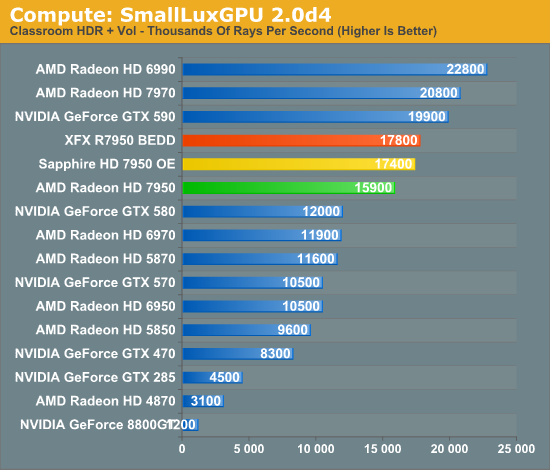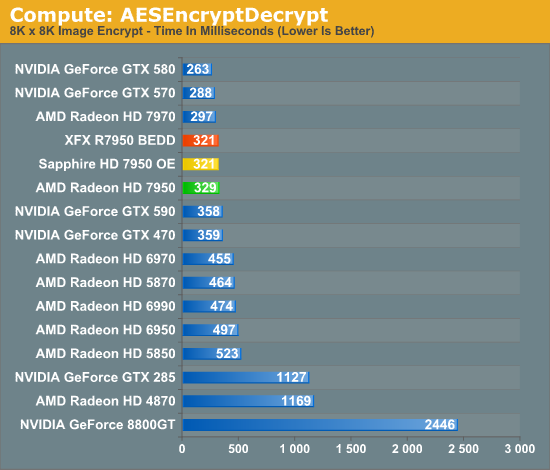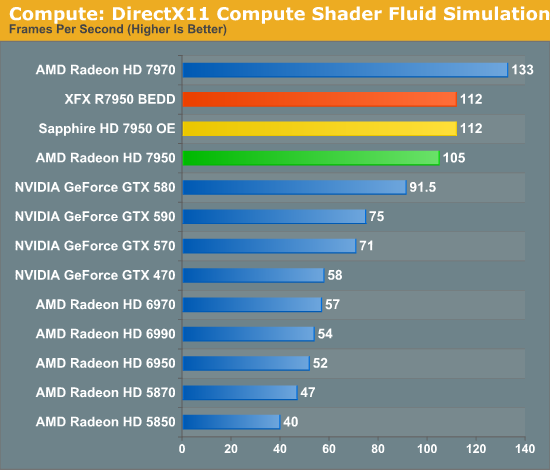AMD Radeon HD 7950 Review Feat. Sapphire & XFX: Sewing Up The High-End Market
by Ryan Smith on January 31, 2012 9:02 AM ESTCompute Performance
Moving on from our look at gaming performance, we have our customary look at compute performance. Since compute performance is by definition shader bound, the 7950 is at a bit of a disadvantage here compared to gaming performance. Whereas ROP performance scales with the core clock, shader performance is hit by both the reduction in the core clock and the disabled CU array.
Our first compute benchmark comes from Civilization V, which uses DirectCompute to decompress textures on the fly. Civ V includes a sub-benchmark that exclusively tests the speed of their texture decompression algorithm by repeatedly decompressing the textures required for one of the game’s leader scenes. Note that this is a DX11 DirectCompute benchmark.

AMD’s greatly improved compute performance continues to shine here, though in the case of Civilization V it’s largely consumed by just closing the previously large gap between the GTX 500 series and the Radeon HD 6000 series. As a result the 7950 falls ever so short of the GTX 580, while the factory overclocked Sapphire and XFX cards give the 7950 enough of a push to come within 5% of the 7970.
Our next benchmark is SmallLuxGPU, the GPU ray tracing branch of the open source LuxRender renderer. We’re now using a development build from the version 2.0 branch, and we’ve moved on to a more complex scene that hopefully will provide a greater challenge to our GPUs.

Under SmallLuxGPU the 7970 enjoyed a large lead over the GTX 580, and this continues with the 7950. Even though the 7950 is well behind the 7970—to the tune of 24%—it’s still 33% ahead of the GTX 580 and the lead only grows from there. Meanwhile the XFX and Sapphire cards can catch up to the 7970 somewhat, but as this is truly a shader-bound test, you can’t make up for the lack of shaders units on the 7950.
For our next benchmark we’re looking at AESEncryptDecrypt, an OpenCL AES encryption routine that AES encrypts/decrypts an 8K x 8K pixel square image file. The results of this benchmark are the average time to encrypt the image over a number of iterations of the AES cypher.

In spite of being a compute benchmark, AESEncryptDecrypt is not particularly sensitive to GPU performance, showcasing the impact that setup times can have. The 7950 trails the 7970 by 10%, and overclocking doesn’t change this much. Unfortunately for AMD NVIDIA is still the leader here, showing that AMD’s compute performance still has room to grow.
Finally, our last benchmark is once again looking at compute shader performance, this time through the Fluid simulation sample in the DirectX SDK. This program simulates the motion and interactions of a 16k particle fluid using a compute shader, with a choice of several different algorithms. In this case we’re using an (O)n^2 nearest neighbor method that is optimized by using shared memory to cache data.

With the compute shader fluid simulation we once again shift back into a compute task that’s much more shader-bound. The 7950 only reaches 80% of the performance of the 7970, once more proving the real impact of losing a CU array. This is still enough to handily surpass the GTX 580 however, with the 7950 taking a 15% lead.










259 Comments
View All Comments
MrBungle123 - Tuesday, January 31, 2012 - link
I don't think Anandtech is read by the "average user"... I would assume mostly gamers, enthusiasts, and IT pros here. Besides who buys 1920x1080 monitors? If the monitor isn't 1920x1200 or higher its not worth buying.Ryan Smith - Tuesday, January 31, 2012 - link
Hi poohbear;When drawing out the tests for the current GPU benchmark suite we debated between 1920x1200 and 1920x1080. Ultimately it was decided that 1920x1200 would be more useful for our needs and that 1920x1080 would be unnecessary; 1920x1080 is only slightly lower in resolution, so our 1920x1200 numbers are only slightly worse in performance than they would be with 1920x1080. The two should be treated as the same, as there's generally not nearly enough of a difference to matter.
-Thanks
Ryan Smith
Pantsu - Tuesday, January 31, 2012 - link
It seems there's two choices for 7950, either a 450€+ custom OC card or a "v2" reference cheapo-PCB cards that go for 400€ in Europe. It would certainly be interesting to get a detailed look at how much of a difference that makes. To me those "v2" cards look a bit too nerfed in terms of VRM and cooling.IMO 7950 is priced accordingly and is no question better than a GTX 580 by any metric really. That's enough to justify a similar price. It's up to Nvidia to drop the GTX 580 price to compete, but I doubt they'll do that, and instead wait for GK104 to save the day. If it is a success we could see prices drop fast in the high end, but Nvidia isn't known for its low pricing, and neither does it have any need to try grab market share by undercutting its profits. There's a good cap between 7800 and 7900 and they could just occupy it with a GK104 and call it a day, until they get their big chip ready.
marc1000 - Tuesday, January 31, 2012 - link
Any word on 7870 from amd?UMADBRO - Tuesday, January 31, 2012 - link
Feb 15marc1000 - Tuesday, January 31, 2012 - link
Ty!just4U - Tuesday, January 31, 2012 - link
That Sapphire cooler looks pretty much like their Dirt3 Edition 6950s one. A slightly different plastic shroud but fan's and underlay seem mostly the same.. atleast in the picture views I've seen.gamoniac - Tuesday, January 31, 2012 - link
I found that, in IE 9, I have to click on the "Back" button on the browser six to seven times to actually go back to the main page. Taking a closer look at it, I noticed there are a bunch of "Share this Page" history item between this page (Ryan's HD7950 Review) and the main page that took place without my knowledge. Would this be a site bug or a advertisement bug?Ryan Smith - Tuesday, January 31, 2012 - link
To the best of my knowledge (please keep in mind that I'm not responsible for site development), that's not something the site should be doing. In which case it could very well be an ad bug. If it continues to happen you should be able to use the IE9 developer tools (built-in, F12), to try to narrow down what exactly it is you're seeing.gamoniac - Tuesday, January 31, 2012 - link
Without spending too much time on it, I can see that there were a bunch of frame navigation caused by sharethis.com, which I think is the likely culprit. I am able to reproduce this issue on two separate Win7 SP1 machines; one of them is clean with almost installed except for the usual PDF reader and some benchmarking tools.Check out these three images I uploaded:
In the beginning:
http://i43.tinypic.com/nqwgti.jpg
Problem captured:
http://i44.tinypic.com/jai5gk.jpg
IE9 F12 screen shot showing frame navigation:
http://i44.tinypic.com/14y226q.jpg
Good luck.